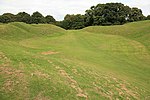Cirencester Park
Cricket grounds in GloucestershireEnglish cricket ground stubsSports venues completed in 1853Use British English from February 2023
Cirencester Park is a cricket ground in Cirencester, Gloucestershire. The first recorded match on the ground was in 1853, when Cirencester played an All-England Eleven.In 1879, Gloucestershire played a single first-class match at the ground against Surrey, which ended in a draw.In local domestic cricket, the ground is the home venue of Cirencester Cricket Club.
Excerpt from the Wikipedia article Cirencester Park (License: CC BY-SA 3.0, Authors).Cirencester Park
South Terrace, Cotswold District
Geographical coordinates (GPS) Address Nearby Places Show on map
Geographical coordinates (GPS)
| Latitude | Longitude |
|---|---|
| N 51.71745 ° | E -1.98443 ° |
Address
South Terrace
South Terrace
GL7 1QT Cotswold District
England, United Kingdom
Open on Google Maps









